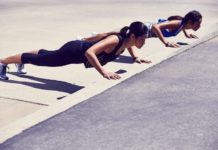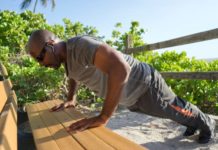
10 Signs Your Walking Workout is Too Easy
Going for a couple of strolls around the block can help you reach your step goals, but it doesn’t necessarily mean you’re getting a good workout. For walking to lead to health benefits like decreased risk of heart disease, stronger bones, weight loss, improved sleep and a mood boost, you have to do more than put one foot in front of the other.
If you’re not sure whether your walks meet the criteria for an actual workout, here are 10 signs your walking routine might be too easy:
YOU DON’T BREAK A SWEAT
It’s a good sign when there are beads of sweat on your forehead, and your clothes feel a little damp after a walk. “A gentle stroll, is, quite literally, no sweat for your body,” says Jonathan Ross, spokesperson for the American Council on Exercise and author of “Abs Revealed.”
Increasing the intensity of your walks activates your sweat glands; the more intense the workout, the more likely you are to break a sweat. But sweating is not the only indicator of a good workout, according to Ross.
Your goal should be to break a sweat while hitting your target heart rate, the “aerobic zone” that indicates you’re getting a cardiovascular workout. An ideal target heart rate is at least 60% of your maximum heart rate — and that number depends on your age.
To calculate your maximum heart rate, subtract your age from 220. For example, a 30-year-old would have a maximum heart rate of 190; 60% of 190 is 114 — this is your target beats per minute, which can be checked by putting your finger on the pulse in your neck or wearing a heart rate monitor. Aim to spend at least 30 minutes in this target zone.
YOU’RE NOT HITTING WEEKLY EXERCISE TARGETS
The Centers for Disease Control and Prevention guidelines advocate for at least 150 minutes of moderate-intensity physical activity per week. You’ll hit the recommended number of minutes by taking a slow stroll around the block for 30 minutes five evenings per week, but you might not reach the intensity to be considered adequate physical activity.
If sustaining a moderate-intensity pace for 30 minutes seems daunting, Erin Oprea, USANA Fitness Ambassador and celebrity personal trainer, suggests breaking it up into shorter spurts. Brisk 10-minute walks before work, during lunch and in the evening still count toward your weekly exercise goals. “If you’re busy, getting multiple brisk walks in every day should be on your to-do list to get your steps in,” Oprea says.
YOU CAN EASILY CARRY ON A CONVERSATION
If you’re able to chatter endlessly about the latest TV show without huffing and puffing, you need to pick up the pace. “If you’re speaking at normal conversational speed, it’s unlikely you’re working out at a sufficient intensity to deliver a challenge to the body,” Ross explains. “As intensity goes up, you should notice you’re able to say fewer and fewer words between breaths.”
It’s OK to talk to your walking partner (or sing along with your workout playlist), but the effort should require you to stop between sentences to catch your breath. “The sweet spot for most people is about 3–6 words spoken before taking a breath,” says Ross.
YOUR MUSCLES NEVER ACHE
Walking is a great low-impact exercise, but it should still feel like a challenging workout. A lack of muscle aches is a strong sign you’re not pushing yourself hard enough. Your goal is a light muscle ache. If you’re too sore to move the next day, you’ve overdone it and should scale back the intensity on your next walk.
You don’t have to give up walking for running or another workout. Picking up the pace, increasing the distance or changing the terrain can all help fire up your muscles and increase the calorie burn. “Find some hills and sweat a little,” says Oprea.
YOU FOLLOW THE SAME ROUTE
It’s easy to find a route you like and stick to it. Over time, your body gets used to a certain pace and terrain; the more you follow the same route, the easier it gets. “Even turning down a few different streets while otherwise following the exact same route is enough to do the trick,” says Ross.
There is no such thing as a “bad” walk. When your goal is walking for exercise and health benefits, it’s essential to make sure your walking routine isn’t too easy — and if it is, challenge yourself to amp it up.
YOU WALK THE SAME DISTANCE IN THE SAME AMOUNT OF TIME
Even if you do mix up your route, it’s possible to get stuck walking the same distance at the same intensity level. While this distance and pace might have been challenging when you first started, eventually your body adapts to the effort and it won’t feel as difficult. It may mean you’re in better shape, but it can also cause a plateau in your fitness level. For this reason, it’s important to vary the distance and intensity of your weekly walks. Take this walking test every month to check in with your fitness level and push yourself to up the cadence.
YOUR WALKS HAVE BECOME BORING
If you find you quickly become bored on most of your walks and need podcasts, music, chats on the phone with friends, or other distractions to keep you interested, this could be a sign you aren’t pushing yourself hard enough. Here’s a short interval session you can try during your regular walks that can help to break up the pace and the monotony:
- After you’re warmed up, try walking at your top speed for 1 minute. Return to your normal pace for 5 minutes and repeat 3–5 times. Focus on faster leg turnover and arm swing with good posture. If you’re up for a more significant challenge, you can try several 30–60 second jogging intervals instead. Cool down with your normal walking pace for the last 5 minutes of your walk.
YOU HAVEN’T NOTICED ANY CHANGES IN YOUR BODY
Getting stronger, losing weight and improving your endurance are common goals when beginning a daily walking routine. While it can take some time to see results, if you’ve been consistent over several months and aren’t seeing any noticeable changes in your body composition or endurance level, this could be a sign it’s time to start pushing yourself a little harder on occasion. Keep in mind diet plays a big role, too, so as long as you’re eating nutritious foods 80% percent of the time and burning more calories than you’re consuming, you should see results.
A good place to start is using the MyFitnessPal app to track your calorie consumption and expenditure each day. From there, you can identify nutrition and fitness trends and make any necessary adjustments to achieve your desired results.
YOU DON’T FEEL A SENSE OF ACCOMPLISHMENT
Without a doubt, finishing a tough workout can feel really good. In addition to the endorphins released, which provide that “runner’s high” feeling, pushing yourself should also provide you with a sense of accomplishment. You’ve done something tough, challenged yourself, and you should feel proud of the work you’ve done. If you don’t, it could be a sign your workouts are no longer as challenging as they should be.
Seek a new challenge you can feel good about, whether that’s walking a half-marathon or marathon, hiking on a new, more difficult path, or adding bodyweight exercises to each walk.
YOU’RE NOT SLEEPING WELL
One of the many great benefits of any fitness routine is the positive effect it can have on the quality of your sleep. After a challenging walking workout, falling and staying asleep should be much easier, especially compared to days you don’t exercise. Research shows walking improves sleep quality and duration, since hormones and proteins released during intense exercise can help the body regulate sleep patterns. If you don’t feel tired at the end of the day or feel like you could easily do another workout, chances are you need to up the intensity or duration of your next walk.
Originally published December 2017, updated with additional reporting by Marc Lindsay
To become more active, try setting a simple goal to increase (and track) your daily steps. Go to “Plans” in the MyFitnessPal app and choose a 28-day step plan to learn tips to boost your activity.
































